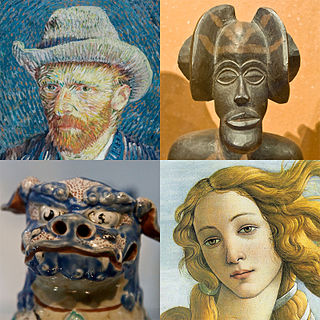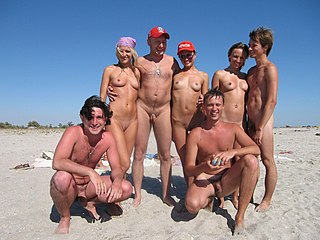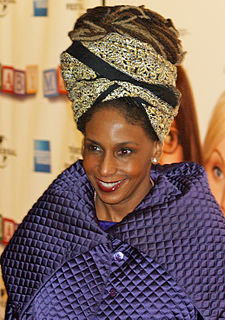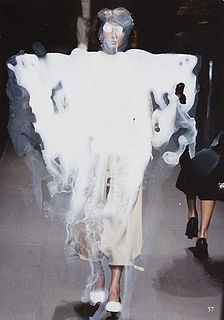
Art is a diverse range of human activities in creating visual, auditory or performing artifacts (artworks), expressing the author's imaginative, conceptual ideas, or technical skill, intended to be appreciated for their beauty or emotional power. In their most general form these activities include the production of works of art, the criticism of art, the study of the history of art, and the aesthetic dissemination of art.

Desmond John Morris is an English zoologist, ethologist and surrealist painter, as well as a popular author in human sociobiology. He is known for his 1967 book The Naked Ape, and for his television programmes such as Zoo Time.

Naturism, or nudism, is a cultural and political movement practicing, advocating, and defending personal and social nudity, most but not all of which takes place on private property. The term may also refer to a lifestyle based on personal, family, or social nudism. Naturism may take a number of forms. It may be practiced individually, within a family, socially, or in public. Additionally, there is also militant naturism, including campaigning, and extreme naturism is sometimes considered a separate category.

Bartholomew was one of the twelve apostles of Jesus from ancient Judea. He has also been identified as Nathanael or Nathaniel, who appears in the Gospel of John when introduced to Jesus by Philip, although many modern commentators reject the identification of Nathanael with Bartholomew.

Alex Grey is an American visionary artist, author, teacher, and Vajrayana practitioner. His body of work spans a variety of forms including performance art, process art, installation art, sculpture, visionary art, and painting. Grey is a member of the Integral Institute. He is also on the board of advisors for the Center for Cognitive Liberty and Ethics, and is the Chair of Wisdom University's Sacred Art Department. He and his wife Allyson Grey are the co-founders of The Chapel of Sacred Mirrors (CoSM), a non-profit church supporting Visionary Culture in Wappingers Falls, New York.

Renee Cox is a Jamaican-American artist, photographer, lecturer, political activist and curator. Her work is considered part of the feminist art movement in the United States. Some of the best known of her provocative works are Queen Nanny of the Maroons, Raje and Yo Mama's Last Supper, which exemplify her Black Feminist politic. In addition, her work has provoked conversations at the intersections of cultural work, activism, gender, and African Studies. As a specialist in film and digital portraiture, Cox uses light, form, digital technology, and her own signature style to capture the identities and beauty within her subjects and herself.

Lieutenant-Colonel Charles Hamilton Smith, KH was an English artist, naturalist, antiquary, illustrator, soldier, and spy.

Beryl Cook, OBE was an English artist best known for her original and instantly recognisable paintings. Often comical, her works pictured people whom she encountered in everyday life, including people enjoying themselves in pubs, girls shopping or out on a hen night, drag queen shows or a family picnicking by the seaside or abroad. She had no formal training and did not take up painting until her thirties. She was a shy and private person, and in her art often depicted the flamboyant and extrovert characters she would like to be.

Depictions of nudity include visual representations of nudity through the history, in all the disciplines, including the arts and sciences. Nudity is restricted in most societies, but some depiction of nudity may serve a recognized social function. Clothing also serves as a significant part of interpersonal communication, and the lack of clothing needs to have a social context. In Western societies, the three contexts that are easily recognized by a majority of individuals are art, pornography, and information or science. Any image not easily fitting into one of these categories may be misinterpreted, leading to disputes.

Feminist art is a category of art associated with the late 1960s and 1970s feminist movement. Feminist art highlights the societal and political differences women and those of other gender identity experience within their lives. The hopeful gain from this form of art is to bring a positive and understanding change to the world, in hope to lead to equality. Media used range from traditional art forms such as painting to more unorthodox methods such as performance art, conceptual art, body art, craftivism, video, film, and fiber art. Feminist art has served as an innovative driving force towards expanding the definition of art through the incorporation of new media and a new perspective.

Nude photography is the creation of any photograph which contains an image of a nude or semi-nude person, or an image suggestive of nudity. Nude photography is undertaken for a variety of purposes, including educational uses, commercial applications and artistic creations. The exhibition or publication of nude photographs may be controversial, more so in some cultures or countries than in others, and especially if the subject is a minor.

The nude figure is a tradition in Western art, and has been used to express ideals of male and female beauty and other human qualities. It was a central preoccupation of Ancient Greek art, and after a semi-dormant period in the Middle Ages returned to a central position in Western art with the Renaissance. Athletes, dancers, and warriors are depicted to express human energy and life, and nudes in various poses may express basic or complex emotions such as pathos. In one sense, a nude is a work of fine art that has as its primary subject the unclothed human body, forming a subject genre of art, in the same way as landscapes and still life. Unclothed figures often also play a part in other types of art, such as history painting, including allegorical and religious art, portraiture, or the decorative arts.

Nudity, or nakedness, is the state of wearing no clothing.
Fine art nude photography is a genre of fine-art photography which depicts the nude human body with an emphasis on form, composition, emotional content, and other aesthetic qualities.
Tamar Garb FBA is Durning Lawrence Professor in the Department of History of Art at University College London. A researcher of French art of the late nineteenth and early twentieth centuries, Garb has published numerous catalogue essays and books that address feminism, the body, sexuality, and gender in cultural representations. Garb has also written essays about numerous contemporary artists, such as Christian Boltanski, Mona Hatoum, Nancy Spero, and Massimo Vitali. Garb has also organized several art exhibitions, including Reisemalheurs at the Freud Museum in London in 2007, and Figures and Fictions: Contemporary South African Photography at the Victoria and Albert Museum in London in 2011. More recently, she has been researching and publishing on the history of art and photography in post-apartheid South Africa, including curating exhibitions on this subject. Garb's exhibition Figures and Fictions was nominated for a Lucie award in Curating.

Intersex, in humans and other animals, describes variations in sex characteristics including chromosomes, gonads, sex hormones, or genitals that, according to the UN Office of the High Commissioner for Human Rights, "do not fit typical binary notions of male or female bodies".
Ewa Partum is a poetry artist, performance artist, filmmaker, mail artist, and conceptual artist. Her involvement with feminist movements and themes includes the WACK! Art and the Feminist Revolution in Los Angeles in 2007. Her honors include an exhibition honoring female artists’ work at the Regional Contemporary Art Fund of Lorraine in Metz, France.

Art of Myanmar refers to visual art created in Myanmar (Burma). From the 1400s CE, artists have been creating paintings and sculptures that reflect the Burmese culture. Burmese artists have been subjected to government interference and censorship, hindering the development of art in Myanmar. Burmese art reflects the central Buddhist elements including the mudra, Jataka tales, the pagoda, and Bodhisattva.
Body horror or biological horror is a subgenre of horror which intentionally showcases graphic or psychologically disturbing violations of the human body. These violations may manifest through aberrant sex, mutations, mutilation, zombification, gratuitous violence, disease, or unnatural movements of the body. Body horror was a description originally applied to an emerging subgenre of American horror films, but has roots in early Gothic literature and has expanded to include other media.

















